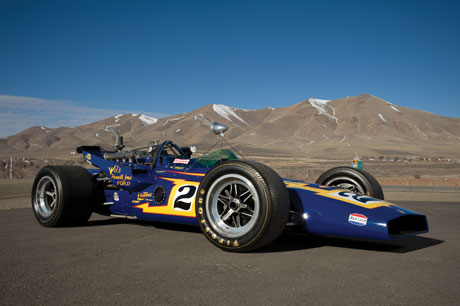SCM Analysis
Detailing
| Vehicle: | 1968 Lola-Colt T150 |
| Years Produced: | 1968 |
| Number Produced: | 3 |
| Original List Price: | n/a |
| Distributor Caps: | $200 |
| Chassis Number Location: | Tag on tub in cockpit |
| Engine Number Location: | n/a |
| Club Info: | Historic Champ/Indy Car Association 2640 Park Blvd #4 Palo Alto, CA 94306 |
| Website: | http://www.champindycar.com |
| Investment Grade: | B |
This 1968 Lola-Colt T150 Indy Car sold for $82,500, including buyer’s premium, at RM’s Icons of Speed & Style auction in Los Angeles, California, on September 26, 2009.
I’m going to lead with my chin on this one. This T150 Indy Car was an absolutely fabulous deal for whoever bought it, selling for, at the very best, half of what it should have brought. Why this happened has a number of possible answers, but there are definitely important lessons for both buyers and consignors.
First, let’s talk about the Lola-Colt T150. One of the problems with Indianapolis and U.S. championship cars has always been that they’re not at all user friendly if you actually want to run them. The front-engined Indy roadsters that dominated through the mid-1960s were big, brutal things made to run at one speed (wide open) and turn one direction (left) while being driven by muscular (real) men for whom comfort and survival were secondary concerns. They are now almost exclusively limited to being static displays in museum-style collections and to doing occasional genteel demo laps on various ovals.
A classic example of the vintage race-able Indy car
After the mid-engined revolution, technology turned the “Champ Cars” of the modern era into incredible racing machines that unfortunately require elite-level driving skills, corporate-level funding, and huge support teams. Thus, these too are relegated to static display in collections and sports bars. In the middle of these two basically unusable bookends was a short period when the mid-engined concept had been accepted, but before high-tech systems had taken over. If you’re a vintage racer, this was a golden time. Road racing had been allowed to take a legitimate seat alongside ovals for championship points, so the cars turned both ways and stopped, as well as hurtling around in circles, and they were still low-enough tech that you could run them competitively out of a well-staffed garage.
The “Johnny Lightning Special” is a classic example of this middle bunch-the vintage race-able Indy car. If you look beneath the fancy graphics and imposing history, this is really an early Lola Formula 5000 with a turbocharged 4-cam Ford engine and some minor concessions to Indy rules. I’m not trying to belittle it-one of the greatest drivers of recent American history plied his trade in the seat for several years. The point is that, much like the European Formula One cars of the same era, this is a car you can actually use.
Admittedly, you’d want to put a road-racing snail on the turbocharger, which knocks a few hundred horsepower off the top end but gives it a useable torque range, and admittedly, your wallet had better be pretty fat every 20 or so hours when that complicated engine needs to be refreshed. But this is a car a competent driver could take to the track and flog for a weekend just for the joy and giggles. Virtually any vintage event would happily find room to include it.
So what about value? Why did it sell for so little? A knowledgeable buyer would understand that it hadn’t run in at least six years and will need something like $40k before it hits the track, but it still sold for a Formula 5000 price, rather than that of a Championship car with history. You couldn’t think about a roughly equivalent Formula One car for less than four to five times the money. The engine alone is worth half what the car sold for.
Perhaps buyers didn’t know about it
What happened? I think there are several aspects to this sale. First, most people don’t think of Indy cars as things you can use, so even the ones you can play with tend to be valued as static display collectibles. Second, value in vintage race cars tends to follow how much racing you can do, and even though you can run a car like this, there aren’t a lot of others out there to go play with. Third, Indy cars aren’t as sexy as Formula One; Brigitte Bardot didn’t hang out in Gasoline Alley like she maybe did at Monaco. I’m afraid that the big reason, though, is that this Lola-Colt T150 Indy Car just went under the radar. I’d guess the serious buyers just didn’t know about it, presented as it was in a sale that featured show cars, hot rods, and dragsters. I didn’t.
So here’s the lesson: If you’re a seller of a special car, make very sure that you consign it to an auction that will attract the appropriate buyers. Don’t put a Lancia in a muscle car auction, and vice versa. If you’re a buyer looking for great deals, don’t ignore an event just because it is filled with cars that don’t interest you. Most auctions, like most wine lists, have a few great values if you pay attention and act when the others aren’t watching. I think that’s what happened here, and somebody got a great deal.
